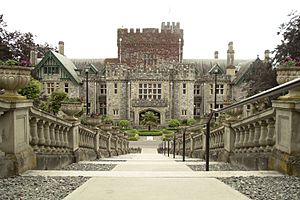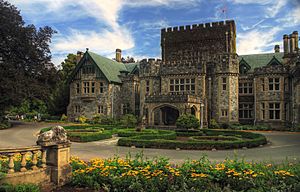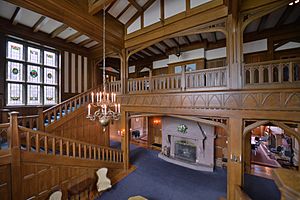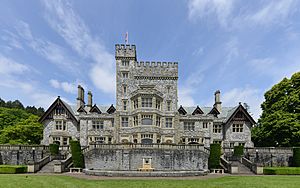Hatley Park National Historic Site facts for kids
Quick facts for kids Hatley Park |
|
|---|---|
 |
|
| Type | University Museum Historic House Museum |
| Location | 2005 Sooke Road Colwood, British Columbia, Canada |
| Built | 1908–1913 |
| Built for | James Dunsmuir |
| Architect | Samuel Maclure |
| Architectural style(s) | Tudor Revival |
| Owner | Royal Roads University |
| Official name: Hatley Park / Former Royal Roads Military College National Historic Site of Canada | |
| Designated | 6 July 1995 |
| Reference no. | 868 |
Hatley Park National Historic Site is a beautiful place located in Colwood, British Columbia, near Victoria. It's home to Hatley Castle, a very important old building. Since 1995, the castle and its large property have been used by Royal Roads University. Before that, from the 1940s to 1995, it was a special training school for the navy called the Royal Roads Military College.
The huge grounds of Hatley Park have amazing formal gardens, old farmland, and walking trails. You can explore forests with very tall Douglas fir and western red cedar trees.
Contents
History of Hatley Park
Hatley Castle and Gardens
In 1906, a wealthy man named James Dunsmuir, who was from Scotland, bought this land. He and his wife, Laura, hired a famous Canadian architect named Samuel Maclure. They wanted him to build a huge 40-room mansion. The castle was designed in a style called Tudor Revival, which was popular around 1900.
The Dunsmuirs also created many stunning formal gardens. They worked with well-known American garden designers, Franklin Brett and George D. Hall. The Dunsmuirs named their estate "Hatley Park," just like grand estates in Britain and Europe. The castle became a famous landmark. The Dunsmuir family lived there until 1937, after the Great Depression.
After Laura Dunsmuir passed away in 1937, the estate was sold to the Government of Canada in 1939. The government sold some of the land. In June 1939, many of the castle's items were sold at a public auction.
A special plaque at Hatley Park says:
Hatley Park. This amazing Edwardian park was created for James and Laura Dunsmuir in the early 1900s. At its center is a Tudor Revival mansion. Its beautiful design is made even better by its rich decorations and fine craftsmanship. The grounds have many different native and foreign plants. They go from formal gardens to fun outdoor areas, farmlands, and forests. The Canadian armed forces bought Hatley Park in 1940. It was then used by Royal Roads Military College, but its original Edwardian style was kept.
The Royal Roads Military College band even recorded music in 1983–1984. Their bandmaster, Gabby R. Bruner, wrote a song called "Hatley Park." He also wrote "Dunsmuir Castle" for Queen Elizabeth when she visited in 1983.
In 2008, Hatley Castle celebrated its 100th birthday!
A Royal Home That Almost Was
When Second World War started, there were plans for the British Royal Family to move to Canada if Britain was invaded. King George VI, Queen Elizabeth, and their daughters, Princesses Elizabeth and Margaret, might have lived here. While their main choices were homes in England, Victoria, BC, was a backup plan.
The Canadian government bought Hatley Castle in 1940 to be a royal home. However, the Royal Family decided to stay in London during the war. The Princesses stayed at Windsor Castle.
From Military College to University
The Canadian government turned the mansion into a training center for the navy. From 1948, it was known as the Royal Roads Military College. It was named after the Royal Roads body of water, which is the entrance to Esquimalt Harbour. The military college closed in 1995. That same year, the castle and grounds were named a National Historic Site of Canada.
In September 1995, Royal Roads University opened as a public university. It rents the campus from the Department of National Defence for just $1 a year. The university takes care of the site, including its history and natural areas. They also teach the public about its importance.
Exploring Hatley Gardens
In 1912, the Dunsmuirs hired American landscape architects Franklin Brett and George D. Hall. They designed the entire property. Their plan divided the estate into four main areas. These areas went from nine formal 'garden rooms' near Hatley Castle, to fun outdoor spaces, then to farm fields, and finally to the forest.
During the Dunsmuir family's time, about 100 gardeners worked on the estate. When it was the Royal Roads Military College, about 50 gardeners kept the property beautiful. This shows how much they wanted to keep the estate looking its best.
Hatley Park is on southern Vancouver Island. It has amazing views of the Olympic Mountains in the U.S. The gardens cover about 2.29 square kilometers (565 acres). It's also a popular place for weddings. Today, Royal Roads University has a smaller team of gardeners. Since the university doesn't get money from the government to maintain the site, they focus on making the Japanese, Rose, and Italian gardens look the best.
For a while, the university charged money to enter the main heritage gardens. This helped pay for the high costs of keeping the historical site beautiful. However, since 2019, the gardens are now free to visit!
Hatley Park in Movies and TV
Hatley Park and its castle have been used in many movies and TV shows for over 80 years!
- In the Smallville TV series, Hatley Castle is shown as Luthor Mansion, the home of Lex Luthor.
- The castle has been featured in two X-Men series as Xavier's School for Gifted Youngsters.
- The 1996 TV movie Generation X
- The X-Men film series, starting with X2: X-Men United (2003). It also appeared in X-Men: The Last Stand, Deadpool, and Deadpool 2.
- The castle is the home of Hubert, the dog in The Duke.
- It was used in the 1997 film, Masterminds, as Shady Glen School.
- The castle appeared in the MacGyver TV series.
- In the TV series Seven Days, the castle was used as a home for a royal family.
- In Poltergeist: The Legacy, Hatley Castle was the main office for the San Francisco legacy group.
- Many scenes from Fierce People (2004) were filmed inside and outside Hatley Castle. It was the grand home of the rich Ogden C. Osborne family.
- The final scenes of The Changeling (1979) were filmed inside Hatley Castle.
- Big Time Movie, based on the TV series Big Time Rush, filmed some parts of the property for its 2011 release.
- It is shown in the Arrow TV series as Queen Mansion, the home of Oliver Queen.
- It is shown in the Witches of East End TV series as the Home of the Gardiner family.
- It is shown in The Killing TV series as St. George's military academy.
- It is shown in the Disney movies Descendants (2015), Descendants 2 (2017), Descendants 3 and Descendants: The Rise of Red (2024) as Auradon Prep. This is the school for the children of Disney fairy tale characters.
- It is shown in the TV series The Dead Zone.
- It is shown in the Fox TV series Bones as the Magic Palace.
- It was featured in the 2018 film The Professor.
- It hosted the starting line of The Amazing Race Canada 6.
- The staircase is shown in the CW TV series Supernatural at an abandoned asylum.
- The outside of the castle was used as a fancy hotel in the 1992 film Knight Moves.
Buildings at Hatley Park
The Canadian government lists several important buildings at Hatley Park National Historic Site.
| Building (Year built) | What it's known for |
|---|---|
| Guard House Building 38 | A recognized historic building since 2002. |
| Belmont Road Main Gatehouse BEL 13 (1908) | A recognized historic building since 2000. |
| Cedar Building (Building 6) (1912–1916) | A recognized historic building since 2000. This building was once a dairy and cattle barn. It was later changed into classrooms and labs for science. |
| Gatehouse Lodge RR8 (1912 to 1916) | A recognized historic building since 2000. |
| Grant Building Building 24 (1942) | A recognized historic building since 1990. This is the main academic building with classrooms, labs, a cafeteria, and offices. It's named after Captain John Moreau Grant, the first leader of HMCS Royal Roads. |
| Gymnasium - sports complex (1942) | This building has a gymnasium, weight room, fitness studio, and squash courts. There are also outdoor tennis courts. |
| Hatley Castle (1908) | This is the main office building for Royal Roads University. From 1941 to 1943, the Castle was used as a place for students and officers to sleep and eat at the military college. It was named a Classified Federal Heritage Building in 1986. |
| Hatley Park / Former Royal Roads Military College (1908–1913) | This entire area was named a National Historic Site of Canada in 1995. |
| Millward Building (Building 21) (1991) | This building has offices and dormitories (places for students to sleep). It's named after Air Vice-Marshal James Bert Millward, a former leader of the military college. |
| Nixon Block RR24A (1954 to 1956) | A recognized historic building since 2000. This building has classrooms and dormitories. It's named after a former leader of the Royal Naval College of Canada, Mr. Nixon. |
| Sherman Jen Building (Stable / Garage) RR4 (1914) | A recognized historic building since 2000. This building was once James Dunsmuir's stables and garage. It was later changed into classrooms and a social center. In 2018, it was renovated and renamed to honor Dr. Sherman Jen, who donated money for the changes. |
| Swimming Pool RR22A (1959) | A recognized historic building since 2000. This is a two-story building made of white concrete. |
See also
 In Spanish: Castillo Hatley para niños
In Spanish: Castillo Hatley para niños
- Hatley Park, Greater Victoria




